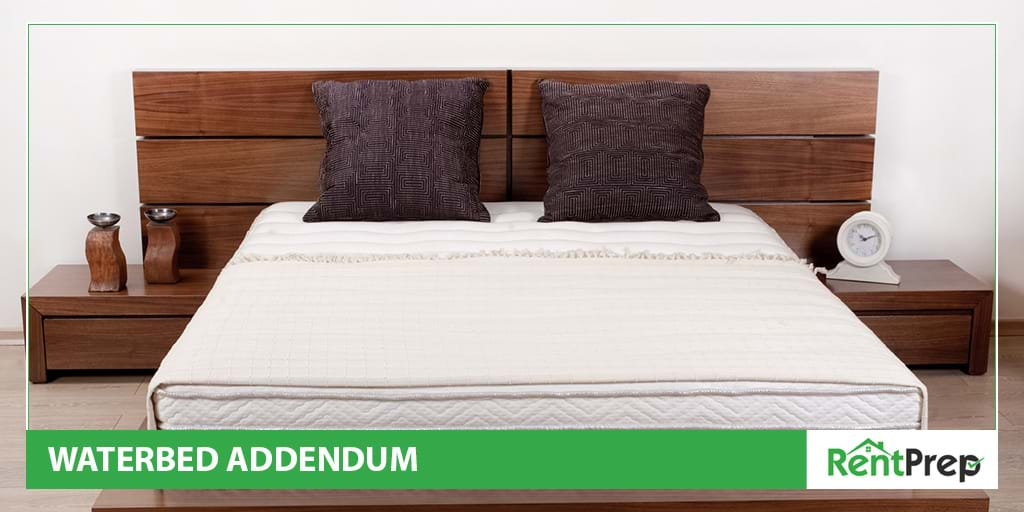
When it comes to the furniture that your tenants bring with them or add to your rental property, you probably aren’t too concerned. Every piece might not fit your style or taste, but they are the ones living there after all!
One piece of furniture that you should be concerned about if a tenant decides to bring one in, however, is a waterbed. Waterbeds pose a heavy risk to properties, and they are often forbidden at rental properties for this reason.
If you want to be lenient and allow your tenant to have a waterbed, you need to do so with some precautions in line. Otherwise, you might end up in a messy (and expensive) situation with no one to blame but yourself.
Using a waterbed addendum is a great way to make sure that your investment is safe from the sleeping needs of your tenant. The addendum will cover everything that the tenant needs to know before they bring in their waterbed, and it will also include some essential protections for you. Let’s take a closer look at how you can use this addendum to your advantage.
A Table Of Contents For Waterbed Spa Addendum Forms
- Why Are Waterbeds Risky?
- Do Landlords Typically Allow Waterbeds?
- What Type Of Protections Are Needed For Waterbeds?
- How To Use Our Free Waterbed Addendum
Why Are Waterbeds Risky?
If you aren’t familiar with waterbeds or how they are often forbidden from rental properties, you might be wondering why this is. How can a bed be a danger to the tenants or the property? There are a few primary reasons that these beds are often excluded in a rental lease.
They’re Heavy
 One of the main reasons that waterbeds may be disallowed is because they are incredibly heavy. The average queen-size waterbed can weigh up to 1,500 pounds. Most properties are built to handle this extra weight with ease, but it can be a bit alarming to bring in something this massive.
One of the main reasons that waterbeds may be disallowed is because they are incredibly heavy. The average queen-size waterbed can weigh up to 1,500 pounds. Most properties are built to handle this extra weight with ease, but it can be a bit alarming to bring in something this massive.
They’re Big Bags Of Water
For all intents and purposes, waterbeds are nothing more than a large liner filled with water. If anything were to happen to the waterbed that caused it to suddenly break or leak, your property could end up covered in water in just a few hours.
If the property in question is in a complex, you might be dealing with more than one damaged unit after all is said and done.
They Require More Insurance
Another reason that some landlords prefer to avoid allowing waterbeds at their properties is because they would need to buy a different or extended type of rental insurance coverage to cover their property.
Most insurance, homeowner’s insurance included, does not cover waterbed damage unless that type of policy is specifically purchased. This means that any and all damages caused by a ruined waterbed are going to put your business’s profit margin at risk.
Additional Risk Factors
Additionally, there are some non-rental related risks that you simply mig ht not want to introduce into your property. Infants and children, for example, are more at risk for injury when there is a waterbed in the home.
ht not want to introduce into your property. Infants and children, for example, are more at risk for injury when there is a waterbed in the home.
Waterbeds themselves typically require some type of electricity as well, and this added cost and the risk of electrical shock can be troublesome for landlords.
Do Landlords Typically Allow Waterbeds?
In most cases, a standard rental lease will include provisions that prevent tenants from owning a waterbed while living at the property. That being said, there are landlords that will allow tenants to use waterbeds so long as a few important rules are followed.
Are Landlords Allowed To Ban Waterbeds?
One interesting question that doesn’t get asked often enough is whether or not a landlord is legally allowed to forbid waterbeds. While some believe that they can because of the inherent risks, others feel that a tenant is paying for the right to use the property as they see fit, and that would include using a waterbed.
To find out the answer, you would need to check into the state and local rental laws in your area.
According to California law, for example, landlords may only outright ban waterbeds in homes that were built before 1973. If the home is newer than that, the landlord cannot ban waterbeds but can require a $100,000 insurance policy, 24-hours installation notice, and that the tenant follows specific rules.
If you aren’t sure what the law says in your area, reach out to a local real estate or property attorney to see if they can point you in the right direction. It’s important to be sure that you are allowed to ban waterbeds before you do it, so take your time and find the right answer.
Fair Housing Laws
Some landlords worry that banning tenants from using waterbeds might be a violation of Fair Housing Laws or another law. If a tenant is disabled and has proof from a doctor that they need to use a waterbed to treat their condition, it is possible that banning waterbeds outright might not be legal.
Still, this situation is unlikely to come up. If it does, remember that you can always allow waterbeds as long as you keep a strict waterbed addendum in place that keeps everything in line!
What Type Of Protections Are Needed For Waterbeds?
If you are thinking about allowing your tenants to use a waterbed at your rental property, there are a number of protections that you will want to make sure you have in place.
First, you will want to double-check whether or not your homeowner’s or rental insurance policies include any specific mention of waterbeds and waterbed damage is covered under the plan. It’s important to know if that kind of coverage will need to be purchased on its own or not.
Second, you will want to make sure that you have the tenants sign a tenant waterbed addendum. This addendum will include all rules, regulations, and provisions that the tenant needs to be aware of when they move a waterbed onto the property.
Without a solid addendum, it’s possible that a rogue waterbed could cost you a lot of money in damages, so you want to be sure that you are prepared for that risk should it occur.
How To Use Our Free Waterbed Addendum
Now that you know more about when and why a watered addendum might be needed, let’s get into the specifics of our free waterbed spa addendum:
| Waterbed Addendum |
While this addendum is just one page long, it contains very important rules and information. As always, remember that you can make adjustments to the specific terms of the addendum to ensure that it is in accordance with your needs and applicable laws, but most will find it easy to use as-is.
Basic Identifying Information
As always, we start the form off with some basic identifying information, including the date, property address, and the tenant name(s). This information should be included on the addendum to be sure that the file and agreement are made with the correct parties; clear identification prevents many unnecessary disagreements.
The Waterbed Rules
The next section outlines the specific rules that are going to apply to allow the waterbed at the property even when the original rental agreement does not permit one. These rules can be tweaked and altered to match what you decide to be permissible at your property as well.
While you can add or change rules as needed, we think it could be beneficial for new landlords and those that are unfamiliar with waterbeds to take a look at our sample rules to set up their own guidelines. Here are the basic tenets of those rules.
Waterbed Requirements
First, the rules cover:
- How thick the mattress must be
- What type of seams are required
- How thick the safety liner must be
- What type of frame is allowed
- Any other standards that might need to be met, such as those of the Waterbed
- Manufacturers Association standards
All of this information is important to ensure that a tenant isn’t going to be able to get away with bringing in a very cheap or low-rated waterbed into your property and put it at additional risk.
Installation
Next, you can and should require that the bed is installed by licensed waterbed professionals. While waterbeds can be moved by anyone, it can be a very difficult process since the bed needs to be drained and refilled, so it is safest for someone that is certified to handle the process.
Bed Location
Clarify where the bed should be located, and emphasize that the tenant must talk to you about any new waterbed placements before they move anything.
Liability Insurance
Next, require that the tenant shows proof of having an insurance policy on the water bed that covers up to a specific amount, such as $100,000. By signing the addendum, the tenant will also be agreeing to keep up with continuous insurance for as long as there is a waterbed on the property.
Cost Coverage
Should any costs for repairs, damages, or losses be accrued because of the new hot tubs, the tenant will be required to pay that sum within a specific period. We suggest keeping it short with a 10-day payment window, but it is ultimately up to you to decide how long it should be.
Additional Security Deposit
It is within your rights as a landlord to charge an additional security deposit fee for the waterbed’s presence on the property. If the tenant moves the waterbed out and no issues occurred, the deposit must be returned to the tenant in full.
Follow The Rules (Or Else)
The final rule is a reminder that all of the previously mentioned tenets must be followed for the arrangement to continue. Should they stop following any of the rules, the waterbed will need to be removed immediately, and any resulting costs will be the tenant’s responsibility.
Signatures
The final aspect of this tenant waterbed addendum is the signatures! Once the landlord and all adult tenants have signed off on the addendum, it will have been officially incorporated into the rental agreement. Should the tenant or you have any disagreements, the final word should be taken from these documents when needed.
Don’t Let Your Investment Get Wet!
If you have a tenant that is very interested in bringing in a waterbed, the final decision about this is up to you. Landlords that decide to permit waterbeds must act to protect their investment by getting a waterbed addendum set up ASAP.
Setting up any addendum can be overwhelming, so we hope that the template and explanation we shared today will make the overall process easier. With any luck, you’ll be able to allow the tenant their special bed without any resulting problems!
Even if you were to have any problems, however, just remember that you have the addendum in place to protect your investment, so you don’t need to sit around worrying!

